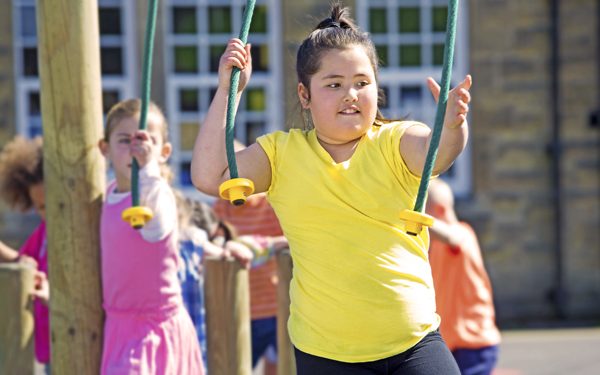By Brain Sutton
A growing epidemic facing the next generation of Americans is childhood obesity. This epidemic will have lasting effects on health, wellbeing, and rising healthcare costs. In fact, childhood obesity has roughly tripled over the past 30 years (1). Experts predict about one in five children and teens are obese while the Centers for Disease Control and Prevention (CDC) estimates 17% (or 12.7 million) of today’s youth (between 2-19) are obese (1,2).
Health consequences of obesity include increased incidents of hyperlipidemia (high cholesterol), hypertension (high blood pressure), asthma, type 2 diabetes, bone/joint/orthopedic problems, sleep apnea, and poor self-esteem (2).
Unfortunately, obese children are more likely to remain obese into their adult years, perpetuating the epidemic (2). Many factors can be attributed to childhood obesity including genetics, a child’s metabolism, physical activity habits, dietary habits, and social and psychological factors.
As such, today’s fitness professional must understand the intricacies of childhood obesity and strategies for helping their young clients live active and healthy lifestyles; ideally in a positive and nurturing environment that improves exercise adherence and healthy lifestyle habits.
Defining Childhood Obesity
Childhood obesity occurs when a child has too much body fat and, as a result, is well above the recommended weight for his or her height. A common measurement tool to estimate a child’s appropriate weight is the body mass index (BMI) scale. While this formula does not calculate specific body fat percentage such as bioelectrical impedance or hydrostatic weighing does, it has proven to be an effective measure for children.
A child’s BMI score is determined differently than an adult’s. Rather than using a mathematical formula, growth charts from the CDC (http://nccd.cdc.gov/dnpabmi/Calculator.aspx) are used to determine a child’s BMI. Growth charts are used because they factor in a child’s growth pattern as they age and accommodate for gender differences through the maturation process.
- Obese = BMI at or above the 95th percentile
- Overweight = BMI at or above the 85th percentile and lower than the 95th percentile
Diet and Physical Activity
Many children are sedentary and spend less time engaged in physical activity (e.g., playtime) as compared to previous generations. Instead they spend their free time watching television, using computers or tablets, and playing video games.
In addition, adolescents are drinking more soda (filled with calories and sugar) and eating less fruits and vegetables (2). Children and adolescents are also consuming too much sodium and do not meet guidelines for whole grain consumption (2). Whole grains, water, fruits and vegetables are being replaced with junk food, fast food and sodas, items laden with excess sugars, saturated fats, and calories.
Due to the alarming increase in childhood obesity, youth fitness guidelines have been developed promoting healthy lifestyles and increased physical activity. According to the U.S. Department of Health and Human Services, children should get 60 minutes (or more) of physical activity daily (5). Children should engage in aerobic, muscle-strengthening, and bone-strengthening activities daily to improve their health and reduce their risk of developing obesity and obesity-related diseases.
Underlying Factors of Childhood Obesity
From the preceding section it is clear that from a purely physiological perspective, energy imbalance is a primary cause in the rise of obesity. That is, an individual consumes more calories from food and beverages than they expend throughout the day. However, energy imbalance is only part of the equation for understanding and battling obesity.
There are several underlying factors as to why an energy imbalance exists in the first place. Some of these factors may include social and ethnic traditions, family/home lifestyles, psychological or physical trauma, and socioeconomic status (e.g., poor versus middle class) (3,4).
Many obese children are not happy with their body’s appearance, leading to poor self-esteem and feelings of low self-worth. This phenomenon can be escalated by harsh treatment from parents, siblings, or classmates (5). Bullying and ridicule oftentimes leads to reclusiveness, withdrawal, and depression. In these instances, lack of physical activity and overconsumption of food oftentimes occurs, perpetuating the energy imbalance experienced by the child. In fact, research indicates, students who are bullied at school are more likely to be obese and miss more school days than non-obese students (3,4).
There are also racial and socioeconomic differences. Obesity rates are higher among Hispanics (21.9%) and non-Hispanic black youth (19.5%) than non-Hispanic white youth (14.7%) (2). In addition, the prevalence of childhood obesity in higher among low-income families (2).
By examining the underlying factors of childhood obesity more closely, it becomes clear that a child’s home and school environment directly impacts their dietary and physical activity habits and overall psychological health. These factors should not be ignored when discussing childhood obesity.
Take Home Message for Fitness Professionals
The underlying causes of childhood obesity are complex. Social and environmental factors play a large role, compounded further by less time engaging in physical activity and eating foods higher in calories, fat and sugar. A combination of these factors has resulted in the increasing epidemic of childhood obesity.
By having a basic understanding about the aforementioned topics, fitness professionals can use their newfound knowledge to gain a closer connection to their young clients. Battling childhood obesity is more than simply counting calories and engaging in intense exercise. It’s being able to empathize and actively listen to clients struggling with their weight and provide strategies that introduce healthy lifestyle habits.

